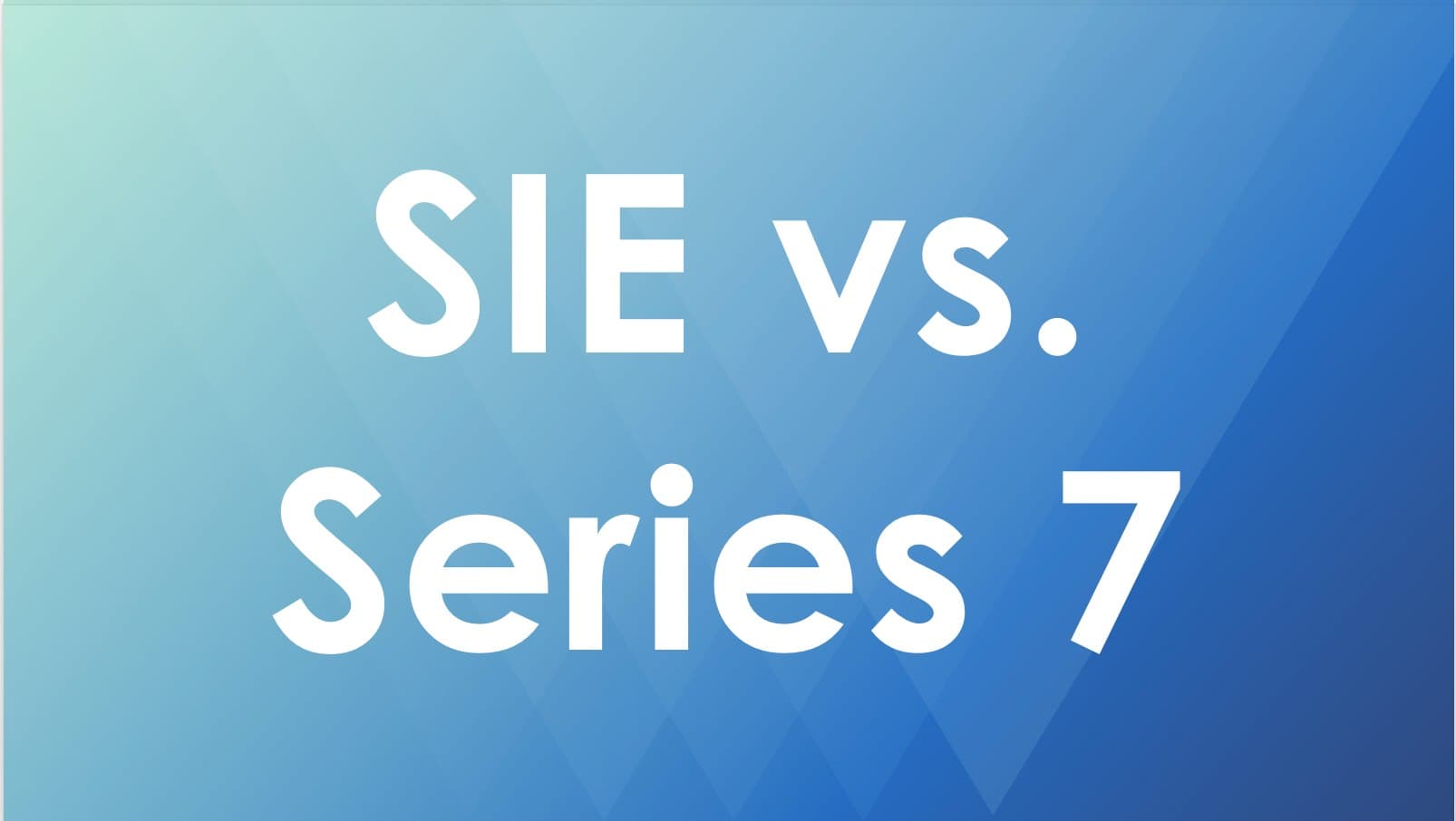
Are the Questions on the SIE Exam Different from Those on the Series 7 Top-Off Exam?
In FINRA’s October 1, 2018, exam restructuring, the legacy Series 7 Exam was effectively split into two new tests: 1) the SIE Exam and 2) the Series 7 Top-Off Exam. As candidates begin to prepare for these examinations, they will find a significant amount of overlap in the information that is tested. Below are examples of just a few of the topics that are covered on both exams:
- Communications with the public
- Capital market activities (e.g., SEC registration, underwriting activities, and exempt transactions)
- Types of customer accounts (e.g., joint accounts and retirement plans)
- Securities products (e.g., equity, debt, investment companies, options, and direct participation programs)
With that in mind, it is important to understand the two major differences between the SIE and Series 7 Top-Off, those being 1) certain content differences and 2) the manner in which the information is tested—both of which are discussed below.
Download Your Free SIE Practice Question Set
Content Differences Between the SIE Exam and Series 7 Top-Off
Although these exams have many topics in common, one of the major differences between them is that the Series 7 Top-Off delves deeper into each content area. For example, while both cover options strategies and calculations, the SIE focuses more on basic options positions, such as single positions and hedging strategies, whereas the Series 7 Top-Off goes a step further and tests on advanced positions, such as spreads and straddles. Similarly, while the SIE covers the basic characteristics of direct participation programs (DPPs), such as limited partnerships, the Series 7 Top-Off delves into the specific types of limited partnerships, including real estate and oil and gas. These are just a couple of examples, though this is the theme for many of the topics covered on both exams.
Additionally, some subjects are tested on the Series 7 Top-Off Exam, but not on the SIE. These include taxation, rules of good delivery, and short sale rules.
The main area tested on the SIE Exam but not on the Series 7 Top-Off is industry rules and regulations. This includes the registration and continuing education of registered representatives as well as business conduct rules, such as the gift limit, outside business activities, and political contributions.
Application of Testable Concepts on the SIE Exam v. on the Series 7 Top-Off
Another major difference is the manner in which overlapping content is tested. As the below examples illustrate, the SIE content is tested more definitionally, particularly on questions concerning products and their risks, whereas the Series 7 Top-Off focuses more on deeper application of the concepts.
SIE and Series 7 Top-Off Sample Questions
Below are three examples of how the same topics, in this case common stock, corporate debt, and mutual funds, might be tested differently on the Series 7 Top-Off Exam compared to the SIE.
SIE Question 1: A major difference between common stock and preferred stock is that
a. common stock pays dividends while preferred stock does not.
b. preferred stock does not offer voting rights while common stock does.
c. common stock is considered an equity security while preferred stock is considered a debt instrument.
d. common shareholders have the right to view company financial statements while preferred shareholders do not.
Series 7 Top-Off Question 1: A young recently married couple will be starting to allocate funds for investment. Both are in their late 20s and each earns over $100,000. Neither considers his or her investment knowledge to be extensive, but they want to start to build an investment portfolio that will offer them growth of their capital without taking an excessive amount of risk. As the registered representative for this couple, you would be most likely to recommend that they start with an investment in a(n)
a. high-yield bond.
b. exchange traded note (ETN)
c. money market mutual fund
d. mid-cap stock.
SIE Question 2: An investor purchased a 4% corporate bond for $975. Subsequently, the price of the bond declined to $950. This investor will receive her next interest payment in the amount of
a. $40.
b. $20.
c. $25.
d. $95.
Series 7 Top-Off Question 2: A couple in their mid-60s is preparing to retire within the next two years. They have significant life savings but continue to seek income from their long-established investment portfolio. They are willing to take some risk at this stage in their lives but do not want to expose their remaining life savings to undue risk, realizing that they may need to tap their assets for health care or other needs. In order to satisfy the goals of this couple, you would be most likely to advise them to purchase a(n)
a. real estate limited partnership.
b. high-grade corporate bond.
c. exchange-listed REIT.
d. blue chip common stock.
SIE Question 3: An investment in an open-end investment company
a. enables an investor to liquidate shares at any time based on the current market quote available.
b. will always require the investor to pay a sales charge at the time of purchase.
c. generally offers diversification to the investor.
d. can be exchange-traded.
Series 7 Top-Off Question 3: Steve recently graduated from college and will be joining a new technology company offering a corporate retirement plan. He will make periodic contributions to this plan through payroll deductions. Steve is looking to build a diversified investment portfolio where he will have exposure to several different sectors of the economy. If you were advising Steve on how to invest his funds, you would likely suggest that he purchase
a. open-end investment company shares.
b. convertible bonds.
c. preferred stock.
d. private placements.
As illustrated in the examples above, candidates can expect the SIE securities products questions to be short, straight to the point, and primarily definition based. The Series 7 Top-Off Exam on the other hand will take these same concepts and make candidates apply them in more detailed scenarios. Because the Series 7 Top-Off will be full of these long, suitability-based questions, candidates should expect it to be a challenging test.
While the product questions on the SIE are not nearly as complex as in the Series 7 Top-Off, the SIE is by no means an “easy” exam. One of the main reasons for this is that, because FINRA eliminated many of the industry rules and regulations from being tested on the Series 7 Top-Off, the SIE Exam is the only place these regulations are now tested. Expect these questions to be the most complex and detailed on the entire exam, since the information is tested on no other FINRA exam.
Answers to SIE questions: 1) B, 2) B, 3) C
Answers to Series 7 Top-Off questions: 1) D, 2) B, 3) A
Written by Ian Franklin
Ian has personally trained over 10,000 students for their qualification exams. As Managing Director of Product Development, Ian is a key driver of the Knopman Marks SIE program, building the textbook, question bank, and diagnostic exams, as well as following up with every trainee enrolled in our program. In addition to the SIE exam, Ian provides training for the Series 3, 7, 50, 52, 57, 63, 65, 66, and 79 exams, and offers one-on-one tutoring to students seeking additional instruction. He graduated with college honors and received a BA from Washington University in St. Louis.
Related posts
- Read more
Exam Tips to Perform Under Pressure
High-stakes securities exams such as the SIE, Series 65, Series 79, or Series 24 can feel overwhe
- Read more
Efficient Exam Prep for Busy Professionals: Strategy Advising
Studying for a high-stakes securities exam like the Series 24 or Series 79 isn’t just about putti
- Read more
Crush the SIE Exam with the Video Vault
Are you feeling overwhelmed by the sheer volume of Securities Industry Essentials (SIE) exam cont


